|
California Native Plant Society
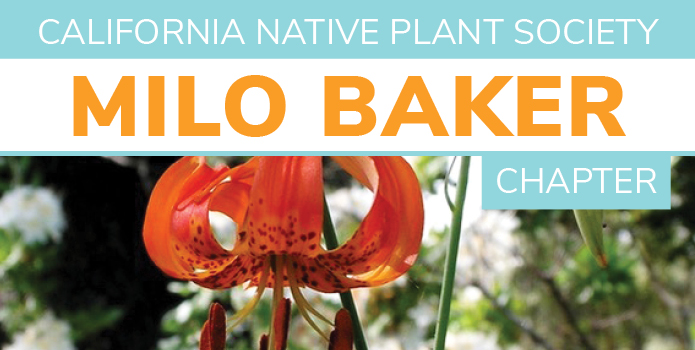 |
April Newsletter
What's in this issue: Speaker Series, Board Update, Eco-Friendly Garden Tour, Plant of the Month, April Plant Walks, Doran Park and Bodega Head Ice Plant Removal, Stewardship Opportunities at Jenner Headlands Preserve, Ongoing Volunteer Opportunities
|
Speaker Series
Third Tuesday of the Month at 7:30 pm
April 18, 2023 (In-person and on Zoom)
Luther Burbank Art and Garden Center, 2050 Yulupa Ave, Santa Rosa, CA 95405
Ongoing Journey Towards Equity
Craig Anderson, Executive Director, Landpaths
LandPaths or "LAND PArtners THrough Stewardship", is an environmental education and conservation leader with the mission to foster a love of the land in Sonoma County. Craig will discuss the journey that LandPaths has been on since he joined the organization in August of 1997. For the past 25 years, LandPaths has been working with community members across the diverse geographic, socio-economic, and cultural palette that comprises Sonoma County to reawaken a "land ethic" that includes not only stewardship of wild lands, but also cultivating a sense that all people belong to this place and have a responsibility to care for it.
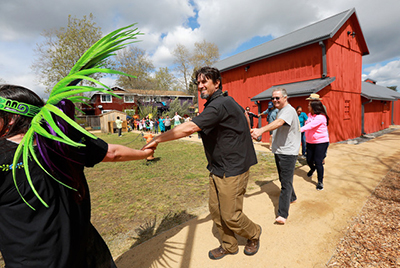 Bio: Craig Anderson (he/him/his) joined LandPaths in 1997 as it was forming to manage a new state park addition at the headwaters of Santa Rosa Creek. As Executive Director, he leads nature preserve acquisitions, assists with "new routes" connecting LandPaths’ preserves by trail through its TrekSonoma initiative, and serves as a liaison with other nonprofit and public agency heads. Bio: Craig Anderson (he/him/his) joined LandPaths in 1997 as it was forming to manage a new state park addition at the headwaters of Santa Rosa Creek. As Executive Director, he leads nature preserve acquisitions, assists with "new routes" connecting LandPaths’ preserves by trail through its TrekSonoma initiative, and serves as a liaison with other nonprofit and public agency heads.
The son of a landscape architect and an art history tutor, Craig supported his college study through summer painting and carpentry jobs in Southern California and rafting and mountaineering schools across the western states. He holds an M.S. in Range Ecology from UC Berkeley, a Life Science teaching credential from UC Santa Barbara, and a B.S. from Principia College.
Craig was profoundly influenced by nature as a child and found solace in the fire roads crossing the Santa Monica Mountains and starting in his teens, California’s Coast Range and Sierra Nevada. He is a student of both music and life sciences, co-leading science-focused semester programs in New Zealand, the Caribbean, and in the Colorado Rockies.
Following shoestring-budget surfing and “mountaineering lite” travels in Asia and Central and South America, Craig worked for Nature Bridge in Yosemite, The Nature Conservancy, University of California Berkeley, and the Ojai Valley and Thacher Schools. In 2014, Craig was honored as Bay Nature Magazine’s Local Hero for Conservation.
He has worked at “re-wilding” himself as an aspiring front-yard farmer, kayak fisherman, musician, hunter and father. Craig believes he must “pay his rent to nature” as he follows in the footsteps of north coast ancestors dating to the 1860s. (photo credit: John Burgess)
You can find the registration link for this presentation at our website: milobaker.cnps.org
We are resuming the before meeting dinners at the Kirin Restaurant, 2700 Yulupa Ave, Santa Rosa. We will meet there at 5:45 pm. Please contact Susan Dean susanepdean@gmail.com if you plan to go.
|
Budding Opportunities – Board Update
– Alynn Kjeldsen, Milo Baker Board Member and Invasive Plant Co-Chair
Flowers are budding and so are opportunities to be involved with the Board. Are you curious about the Milo Baker Board? Have you ever wondered what kind of fascinating things are discussed and debated at our monthly meetings? Are you looking to put your interests and skills into action? Then read on...
The Milo Baker Board meets on the second Tuesday of each month. We do not meet in June, August or December. Typically the President runs the meeting, but as we do not have a current President, Board members will be sharing this role. Meetings start with a welcome to all that are present, and the meeting is opened up for announcements. This is a great time to share interesting presentations that we have been to, upcoming schedule conflicts, generally anything that would be of interest to the Board members that is not on the agenda. Our Treasurer then reports on the current status of our accounts. Next we talk about active business items. For example this month we discussed the upcoming deadline and financing of the scholarships that we award annually, the upcoming Garden Tour responsibilities, and the process of ordering new informational materials. Next are updates from the different Committees. Each committee gives an update on any business that has occurred the past month. For example, the Newsletter Editor and Web Administrator have been building a new Milo Baker chapter website! This soon to be launched new website is the culmination of lots of work from several members. It has been interesting receiving the monthly updates from these members to learn the process and see the amazing progress of our new website.
This is just a sample of the many things that are covered at our monthly meetings. Currently all meetings occur on Zoom. If you are interested in getting involved there are current openings on the Board, and you can also get involved by joining a committee. If you would like to attend a Board meeting, please reach out to a Board member and we can provide the link, https://milobaker.cnps.org/index.php/about/milo-baker-board
|
Eco-Friendly Garden Tour
– Betty Young, Milo Baker Nursery Chair
The 2023 Eco-Friendly Garden Tour will take place on Saturday, May 13th, 2023 from 10am - 4pm. The tour will feature eco-friendly gardens throughout Sonoma and Marin counties.
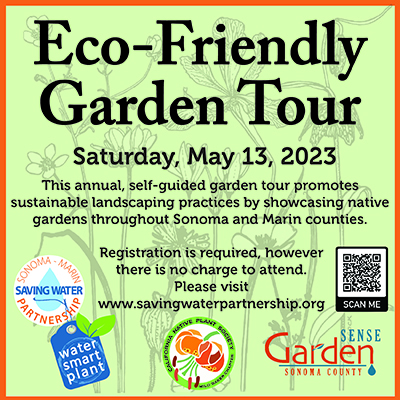
This year's tour will be back to in-person, the first time since 2019! The gardens on the tour this year will be native focused and highlight the importance of landscaping with plants adaptable to our changing climates. A few of the events scheduled at the gardens on this year's tour include; a California Native Plant Society plant sale, free compost pick-up provided by Zero Waste, and informational tables hosted by the Master Gardeners and Garden Sense programs.
Registration is now available. Registration is required, but the event is FREE! Make sure to register and put a reminder on your calendar. We will continue to send out updates as we get closer to the tour. Share with family and friends as the tour provides a great opportunity to be outside, see beautiful gardens, get inspiration and visit with other gardening neighbors.
Oh, did we mention that the tour is on Mother's Day weekend and we will have a plant sale at our nursery at the Laguna Environmental Center, 900 Sanford Rd, Santa Rosa.
|
Plant of the Month
Toyon – Heteromeles arbutifolia
– Liz Parsons, Milo Baker Vice President
As the season changes into spring, the flowering trees and shrubs are putting on quite a show. The toyon, Heteromeles arbutifolia, will soon burst out with clusters of white flowers. It is a member of the Rosaceae or the Rose Family. Toyon is the only species in the genus Heteromeles, which is Greek for different apple. Indeed, botanically, the fruit is a pome, just like the apple. The white flowers will be followed by the red fruits that are so prominent in the winter.
Illustration by Liz Parsons.
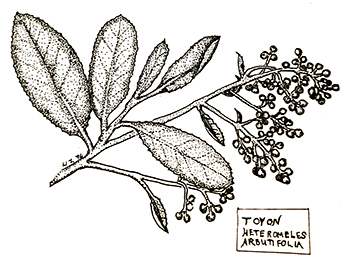 Cotoneaster and Pyracantha are similar members of the Rose family with red fruits in the fall. They have been naturalized and are not native. It is easy to see how the birds can spread the seeds once they have gobbled up the very attractive fruits. One visual difference between the native toyon and the two non-native species is the large size of toyon’s glossy, evergreen leaves that are two to four inches long, 3/4 to 1 1/2 inches across, with sharply toothed edges. The size and habit are also unique. Toyon has up-right, never arching, branches and can grow to 15 feet. In early summer, all three bloom with panicles of many white flowers with five petals, which are followed by the red fruits. Yearly pruning can easily be done when harvesting the branches for holiday decorations. Cotoneaster and Pyracantha are similar members of the Rose family with red fruits in the fall. They have been naturalized and are not native. It is easy to see how the birds can spread the seeds once they have gobbled up the very attractive fruits. One visual difference between the native toyon and the two non-native species is the large size of toyon’s glossy, evergreen leaves that are two to four inches long, 3/4 to 1 1/2 inches across, with sharply toothed edges. The size and habit are also unique. Toyon has up-right, never arching, branches and can grow to 15 feet. In early summer, all three bloom with panicles of many white flowers with five petals, which are followed by the red fruits. Yearly pruning can easily be done when harvesting the branches for holiday decorations.
Toyon is widely distributed around the state, it can be found in chaparral areas and in forested canyons throughout the California Floristic Province, including the foothills of the Sierra Nevada to 4,000 feet. This adaptability has made toyon one of the most popular California natives for landscaping and it was one of the first to be brought into the garden by the pioneers. This handsome shrub suits many needs: an untrimmed hedge, an accent plant, a small tree, erosion control, or a foundation plant. For a dry shrub border, it is indispensable. Toyon likes well-drained soil, and responds to summer water with rapid growth; without extra water it will simply grow more slowly.
E.K. Balls, in Early Uses of California Plants (UC Press, 1962), reports that the CA Indians seldom ate the berries raw, but cooked them by tossing them in a basket with hot coals or pebbles, thus taking away the bitter taste of the fresh fruits. The bark and leaves were used in a medicinal tea to cure aches and pains. According to Mr. Balls: “The name Hollywood was given on account of the number of California-Hollies which grew in the hills about the original subdivision.”
Propagation is easiest with fresh seeds; seeds that have been stored will require 3 month cold stratification (stored in the refrigerator in a damp medium such as perlite, milled peat, potting soil or vermiculite). Harvest the seeds when the fruits are bright red (each will have 2 or more seeds); separate the seeds and plant them in a container with weed free soil, and put the container outside through the winter. The seeds will germinate in the spring. Cuttings of semi-ripe wood, which are taken in the fall, are very successful as are greenwood cuttings taken in the late spring. Use a rooting hormone to ensure success.
All in all, toyon is a highly recommended shrub for ornamental purposes and for attracting wildlife to your garden. Since it occurs naturally in most of the state, it is an excellent choice for any revegetation project or for the habitat garden.
|
April Plant Walks
Monday April 3, 10:00-3:00
Elarra Private Preserve in Glenn Ellen
Leaders: Owners Marc Schwager and Allison Ash, and Botanist Ann Howald
Click here to register
Monday April 10, 10:00-3:00
Modini Mayacamas Preserve
Leader: Peter Warner, Botanist
Click here to register
Tuesday April 11, 11:00-3:00
Woodland Wildflowers of North Sonoma Mountain Regional Park
Leader: Michelle Karle, Regional Park Aide and Ruthie Saia, Certified California Naturalist
Click here to register
Monday April 17, 1:00-4:00
Wildflowers of Jenner Headlands Preserve
Leader: Ruthie Saia, Certified California Naturalist
Click here to register
Monday April 24th 11:00-3:30 and 4:00-5:30
Fairfield Osborn Preserve: Sudden Oak Death Education and Spring Wildflowers
Leaders: Kerry Wininger, SOD Program Coordinator for UCCE Sonoma and Ruthie Saia, Certified Osborn and California Naturalist
Click here to register
For more details about our plant walks please check our website.
To sign up for email alerts contact Milobakerevents@gmail.com
Ruthie Saia, Milo Baker Plant Walk Coordinator
|
Doran Park and Bodega Head Ice Plant Removal
– Jan Lochner, Invasive Plant Co-Chair
 Doran Park Ice Plant Update Doran Park Ice Plant Update
This project just keeps on advancing. In 5 years at Doran Beach, we have cleared the Birdwalk Trail of ice plant, leaving mostly natives and proceeded up along the bay side to the campground. We are now working areas near the entrance of the park, focusing on places where natives are struggling and expecting a strong return when the ice plant is cleared. Next we plan to revisit an area at the East end of the campground that could possibly be plover habitat. Then, in the fall, we will join with parks staff to work near the visitor center boardwalk, installing a native demonstration garden. Photo: Volunteers pull ice plant along the bluffs at the Bodega Marine Lab.
FYI - we do not leave the piles of ice plant for you to admire our work. We let them dry and lighten in weight about 1 year then they are hauled to Recology for compost.
And for diversion, we will go, one Wednesday a month, to the Bodega Marine Lab this spring to help restore the bluffs, which are full of natives – and some ice plant.
This all happens on Wednesdays from 9:30 to 3pm+/- with people coming at their preferred time and staying as long as they like. Text Jan @ 707 569-4724 if you want to join us.
Bodega Head Ice Plant Removal
The Bodega Head project is progressing well. We continue to monitor the ice plant in the area behind the bathrooms as the native plants continue to expand into the space we have provided them. We are now mostly focusing on isolated patches along the trail. We have included wild radish in our eradication plan. All this rain is making the pulling of radish and ice plant much easier! But we have lots to do while the ground is still soft. Every little bit makes the native habitat so much better!
Mark your calendar for the second Sunday of the month from 10:00 to 1:00 at the western Bodega Head parking lot. Email Alynn to be added to the group list for reminders and reschedules (rain): alynnkjeldsen@gmail.com
Warning: Pulling Ice Plant is addicting and satisfying and therapeutic and fun!!
|
Stewardship Opportunities at Jenner Headlands Preserve

Join The Wildlands Conservancy for Goat Grass Rodeo Round-up '23. Every weekend between April 15 and June 4 the Conservancy will host a ranger-led wildflower hike to the preserve's serpentine grasslands followed by an optional 30-minute opportunity to pull invasive barbed goat grass that is threatening this unique habitat. Click here for more information and to register.
|
Ongoing Volunteer Opportunities
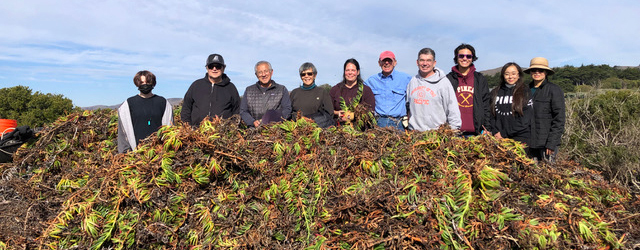
This is a photo of the Kiwanis group that came out to Doran Beach on 11/11 to pull ice plant. They were fantastic and had members of the high school club with them as well. They have cleared over 1000 sq. ft.!!!
Living Learning Landscapes Workday – second Friday of the month (9:30 am - noon). Meet at 1808 Albany Drive in Santa Rosa. Please RSVP to April Owens aprilleeowens@gmail.com so we know to expect you!
Weekly Doran Beach Ice Plant Removal – every Wednesday (9:30 am - 11:30 am). Meet at 9:30 at the Cypress Day Use parking lot, west end. Bring clippers and gloves and knee pads if you like. One of the most pleasant workdays happens every week – a trip to Doran Beach to pull ice plant. We are clearing out the ice plant that is in the marshland to make room for natives. It is very visual and quite satisfying, with the sound of the waves, birds and foghorn.
Bodega Head Ice Plant Removal Project – second Sunday of each month (10:00 am - 1:00 pm). CNPS is leading volunteers at Bodega Head to save native species from getting smothered by ice plant. Meet at the main parking lot near the bathrooms. Bring water, clippers and gloves if you have them. Email Alynn at alynnkjeldsen@gmail.com for more information and to let us know that you are coming.
For more information, please visit the Volunteer Opportunities page on our website.
|
|
|

|
|
|
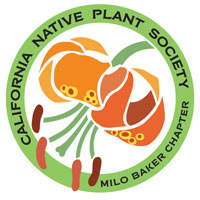
|
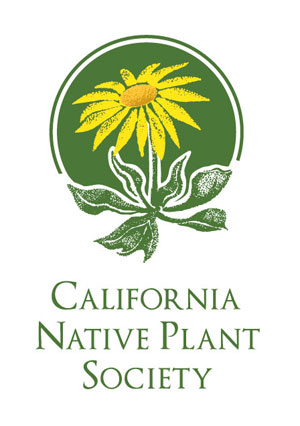
|
|



 Bio: Craig Anderson (he/him/his) joined LandPaths in 1997 as it was forming to manage a new state park addition at the headwaters of Santa Rosa Creek. As Executive Director, he leads nature preserve acquisitions, assists with "new routes" connecting LandPaths’ preserves by trail through its TrekSonoma initiative, and serves as a liaison with other nonprofit and public agency heads.
Bio: Craig Anderson (he/him/his) joined LandPaths in 1997 as it was forming to manage a new state park addition at the headwaters of Santa Rosa Creek. As Executive Director, he leads nature preserve acquisitions, assists with "new routes" connecting LandPaths’ preserves by trail through its TrekSonoma initiative, and serves as a liaison with other nonprofit and public agency heads.
 Cotoneaster and Pyracantha are similar members of the Rose family with red fruits in the fall. They have been naturalized and are not native. It is easy to see how the birds can spread the seeds once they have gobbled up the very attractive fruits. One visual difference between the native toyon and the two non-native species is the large size of toyon’s glossy, evergreen leaves that are two to four inches long, 3/4 to 1 1/2 inches across, with sharply toothed edges. The size and habit are also unique. Toyon has up-right, never arching, branches and can grow to 15 feet. In early summer, all three bloom with panicles of many white flowers with five petals, which are followed by the red fruits. Yearly pruning can easily be done when harvesting the branches for holiday decorations.
Cotoneaster and Pyracantha are similar members of the Rose family with red fruits in the fall. They have been naturalized and are not native. It is easy to see how the birds can spread the seeds once they have gobbled up the very attractive fruits. One visual difference between the native toyon and the two non-native species is the large size of toyon’s glossy, evergreen leaves that are two to four inches long, 3/4 to 1 1/2 inches across, with sharply toothed edges. The size and habit are also unique. Toyon has up-right, never arching, branches and can grow to 15 feet. In early summer, all three bloom with panicles of many white flowers with five petals, which are followed by the red fruits. Yearly pruning can easily be done when harvesting the branches for holiday decorations. Doran Park Ice Plant Update
Doran Park Ice Plant Update

